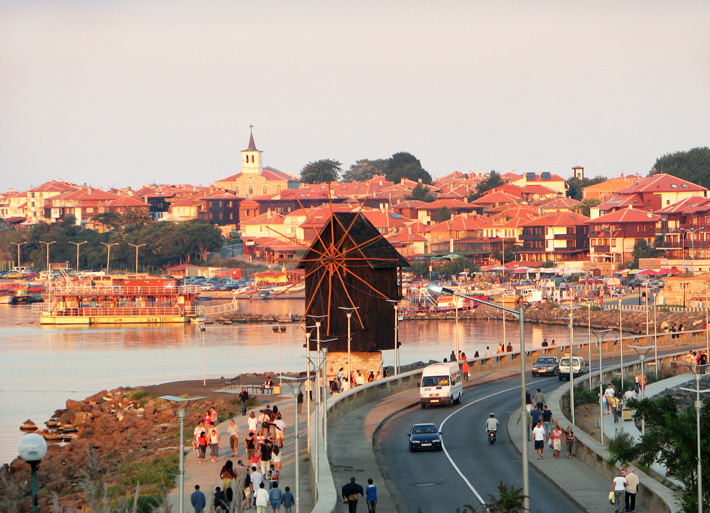nesebar
Nessebar is located in a narrow isthmus on the Black Sea coast in the northernmost part of Burgas region. Its neighbor to the north is the largest Bulgarian Black Sea resort Sunny Beach. The peninsula of Nessebar – the ancient town of Messambria Pontica, named in the late Middle Ages Messambria and later Nessebar, was first inhabited thousands of years ago, at the end of the Bronze Age.
The old Thracians called it Melsambria – the town of Melsa. The Thracian word for “town” is bria, and mena or melsa, probably by the name of the legendary founder of the village. On the other hand, the Old Bulgarian word mena means “exchange” which suggests the meaning “commercial town”, as Messambria was actually known in antiquity. The town has two convenient ports – south and north, where to present day there are numerous remains of ancient vessels.
According to data from antiquity, the legendary author of fables Aesop was born in Messambria around 620 BC. and is of Thracian origin.

When in the 1st century the town was conquered by the Romans, it preserved intact its fortress walls and large public buildings and became part of the Roman Empire. It was named Messemberia. After moving the capital of the Roman Empire to Constantinople and accepting Christianity as an official religion, the conditions for the revival of the Black Sea cities became favorable. Messemberia turns a villa zone of Constantinople. New Christian temples – basilicas, water supply system and urban baths are being built. The central church is named after St. Sophia, as it is in Constantinople. The town was a metropolis until the 1700s.
It was declared an architectural and archaeological reserve in 1956, and in 1983 the cultural monuments in the town were added to the UNESCO World Heritage List. The town is one of the 100 national tourist sites and a UNESCO site by three indicators:
– its location in a narrow isthmus;
– the many well-preserved or restored medieval churches;
– the architecture of the houses and the overall atmosphere of the town.
Pope John XXIII (born Angelo Giuseppe Roncali) was a Vatican nuncius in Bulgaria between 1925 and 1935. On November 30, 1934, he was appointed apostolic delegate for Turkey and Greece and archbishop of Mesemvria. Since his arrival in Bulgaria Monsignor Roncali has been developing a charity for the benefit of refugees from Aegean Macedonia and Thrace. With his help the first kitchen was opened in Nessebar. In October 1935 he led a pilgrimage to Bulgarian Catholics in Rome who he presented to Pope Pius XI.

Part of the architectural and historical reserve of the town are its churches, the most remarkable of which are:
“St. Sofia”, known as the Old Metropolis, is an Orthodox church from the 4th century from which there are only ruins. Inside the church was plastered with mortar and painted. The whole floor was covered with a mosaic of multicolored pebbles. A marble block is preserved, on which is a carved verse of an Old Testament psalm. The fallen plaster sends a heartfelt message to the generations to come: “Let my cry get to you!”. It is located next to the old fountain of Nessebar and to find your way around, search Google Maps “St. Sofia Nessebar”.
“St. Stephen”, also called the New Metropolis, is an Orthodox church from the 10th century. Initially, the church was dedicated to the Virgin Mary, and therefore thematically the frescoes are related to the life of the Holy Mother. When in the eastern part of the town the church of St. Stefan sinks, it has been decided this one to be consecrated as St. Stefan Restored. It is situated very close to “St. Sofia” on “Ribarska” street.
“Christ Pantocrator” (All-Holder) is an Orthodox church from the XIII century and is one of the most impressive and best preserved medieval churches in Nessebar, a typical representative of the picturesque style in church architecture. Only traces of the original frescoes are preserved on the inside of the walls. The church does not function and is used as an art gallery. It is located in the center of the Old Town.
“St. Mary Of Eleusa” (Affection) has been a late Orthodox church since the first half of the 5th century. In the historical springs it was mentioned until the 14th century, when it was part of a monastery complex. Now the church has been preserved and partially restored. It is located at the end of the peninsula and to find your way, search Google Maps ” St. Mary Of Eleusa Nessebar”.
If you have time and you are interested, you can also visit the following museums in Nessebar:
Archaeological – it preserves the millennial history of the town. It is presented in a modern and attractive way for visitors in four halls, chronologically tracking the development of the town through the different historical eras: “Messambria and the Thracians”, “Pontius Polis Messambria”, “Messemvria within the borders of Rome, Byzantium and Bulgaria”, and the fourth hall is dedicated to icon art, the oldest examples of the Nessebar school being from the 13th century. You will easily find it, this is the big building at the beginning of the Old Town, in front of which on the lawn there are exposed parts of stone columns and other architectural elements.
Ethnographic – it is housed in the house of Moscoyani which is one of the most interesting Renaissance monuments. It is a typical representative of the Nesebar residential architecture from the late period of the Bulgarian Renaissance, and the exhibition shows, although partially, the great art of the Bulgarian woman through the exhibition “Costumes and Fabrics from Burgas region”. Unfortunately, at the time we were preparing this information for you, the museum is temporarily closed, but we hope that as the summer season approaches, it will be open to visitors again.
